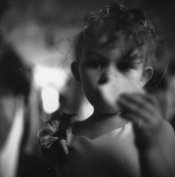Diafine.
Twice.
I'm completely serious, and I've done this. Tri-X processed in Diafine according to instructions (3 minutes Bath A, 3 minutes Bath B) at reasonable temperatures gives EI 1600 the way most folks meter; if you give the film a thorough water rinse after Bath B (to avoid getting any of that solution into the Bath A), you can then put the film back into Bath A for another three minutes, followed by three minutes in Bath B again, then your regular water stop and fix.
Shadow detail will surely be compromised -- that's already a given, based on how you shot the film -- and the results will be fairly grainy. But you'll get good midtones and quite printable negatives if you didn't cheat on the metering even at 3200.
Alternately, you could use Super Soup:
Mix HC-110 Dilution A, using Dektol 1+9 in place of water. Add 1 g/L ascorbic acid, and 1/2 tsp per 8 ounces sodium carbonate (or 25% more sodium ascorbate, and no additional carbonate needed, though I haven't tested with this variation). Agitate very vigorously (7 inversions in 5 seconds) every 30 seconds for 15 minutes, and you'll get approximately EI 5000 from Tri-X -- drop back to 12 minutes, and you should be pretty close to your EI 3200, and likely get better shadow detail than with two cycles of Diafine. Even better, you'll get contrast that's easy to print.

Do, please, test the Super Soup with a roll shot under similar conditions as a test before committing your important images -- it works for me, but I could be specially blessed....















